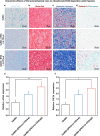Impact of Molecular Dynamics of Polyrotaxanes on Chondrocytes in Double-Network Supramolecular Hydrogels under Physiological Thermomechanical Stimulation
- PMID: 38166194
- PMCID: PMC10865359
- DOI: 10.1021/acs.biomac.3c01132
Impact of Molecular Dynamics of Polyrotaxanes on Chondrocytes in Double-Network Supramolecular Hydrogels under Physiological Thermomechanical Stimulation
Abstract
Hyaline cartilage, a soft tissue enriched with a dynamic extracellular matrix, manifests as a supramolecular system within load-bearing joints. At the same time, the challenge of cartilage repair through tissue engineering lies in replicating intricate cellular-matrix interactions. This study attempts to investigate chondrocyte responses within double-network supramolecular hybrid hydrogels tailored to mimic the dynamic molecular nature of hyaline cartilage. To this end, we infused noncovalent host-guest polyrotaxanes, by blending α-cyclodextrins as host molecules and polyethylene glycol as guests, into a gelatin-based covalent matrix, thereby enhancing its dynamic characteristics. Subsequently, chondrocytes were seeded into these hydrogels to systematically probe the effects of two concentrations of the introduced polyrotaxanes (instilling different levels of supramolecular dynamism in the hydrogel systems) on the cellular responsiveness. Our findings unveiled an augmented level of cellular mechanosensitivity for supramolecular hydrogels compared to pure covalent-based systems. This is demonstrated by an increased mRNA expression of ion channels (TREK1, TRPV4, and PIEZO1), signaling molecules (SOX9) and matrix-remodeling enzymes (LOXL2). Such outcomes were further elevated upon external application of biomimetic thermomechanical loading, which brought a stark increase in the accumulation of sulfated glycosaminoglycans and collagen. Overall, we found that matrix adaptability plays a pivotal role in modulating chondrocyte responses within double-network supramolecular hydrogels. These findings hold the potential for advancing cartilage engineering within load-bearing joints.
Conflict of interest statement
The authors declare no competing financial interest.
Figures




Similar articles
-
Hydrazone covalent adaptable networks modulate extracellular matrix deposition for cartilage tissue engineering.Acta Biomater. 2019 Jan 1;83:71-82. doi: 10.1016/j.actbio.2018.11.014. Epub 2018 Nov 10. Acta Biomater. 2019. PMID: 30419278 Free PMC article.
-
An in vitro and in vivo comparison of cartilage growth in chondrocyte-laden matrix metalloproteinase-sensitive poly(ethylene glycol) hydrogels with localized transforming growth factor β3.Acta Biomater. 2019 Jul 15;93:97-110. doi: 10.1016/j.actbio.2019.03.046. Epub 2019 Mar 23. Acta Biomater. 2019. PMID: 30914256 Free PMC article.
-
Stimuli-responsive biphenyl-tripeptide supramolecular hydrogels as biomimetic extracellular matrix scaffolds for cartilage tissue engineering.Acta Biomater. 2021 Sep 1;131:128-137. doi: 10.1016/j.actbio.2021.07.007. Epub 2021 Jul 8. Acta Biomater. 2021. PMID: 34245894
-
Anatomy, molecular structures, and hyaluronic acid - Gelatin injectable hydrogels as a therapeutic alternative for hyaline cartilage recovery: A review.J Biomed Mater Res B Appl Biomater. 2023 Sep;111(9):1705-1722. doi: 10.1002/jbm.b.35261. Epub 2023 May 13. J Biomed Mater Res B Appl Biomater. 2023. PMID: 37178328 Review.
-
Dynamic Hydrogels from Host-Guest Supramolecular Interactions.Macromol Biosci. 2019 Jan;19(1):e1800281. doi: 10.1002/mabi.201800281. Epub 2018 Oct 10. Macromol Biosci. 2019. PMID: 30303631 Review.
Cited by
-
Tissue engineering strategies hold promise for the repair of articular cartilage injury.Biomed Eng Online. 2024 Sep 11;23(1):92. doi: 10.1186/s12938-024-01260-w. Biomed Eng Online. 2024. PMID: 39261876 Free PMC article. Review.
-
"Heat of the Moment: The Overlooked Key to Cartilage Engineering''.ACS Omega. 2025 Jan 30;10(5):4170-4172. doi: 10.1021/acsomega.4c10624. eCollection 2025 Feb 11. ACS Omega. 2025. PMID: 39959054 Free PMC article. Review.
-
Recent Evidence for Orthobiologics Combined with Hydrogels for Joint Tissue Regeneration: Focus on Osteoarthritis.Gels. 2025 Jul 17;11(7):551. doi: 10.3390/gels11070551. Gels. 2025. PMID: 40710712 Free PMC article. Review.
-
Cyclodextrins as multifunctional tools for advanced biomaterials in tissue repair and regeneration.Bioact Mater. 2025 Mar 27;49:627-651. doi: 10.1016/j.bioactmat.2025.03.018. eCollection 2025 Jul. Bioact Mater. 2025. PMID: 40212783 Free PMC article. Review.
-
Cyclodextrin-Based Supramolecular Hydrogels in Tissue Engineering and Regenerative Medicine.Molecules. 2025 Jul 31;30(15):3225. doi: 10.3390/molecules30153225. Molecules. 2025. PMID: 40807400 Free PMC article. Review.
References
-
- Richardson B. M.; Walker C. J.; Maples M. M.; Randolph M. A.; Bryant S. J.; Anseth K. S. Mechanobiological Interactions between Dynamic Compressive Loading and Viscoelasticity on Chondrocytes in Hydrazone Covalent Adaptable Networks for Cartilage Tissue Engineering. Adv. Healthc. Mater. 2021, 10 (9), 200203010.1002/adhm.202002030. - DOI - PMC - PubMed
Publication types
MeSH terms
Substances
LinkOut - more resources
Full Text Sources
Research Materials

